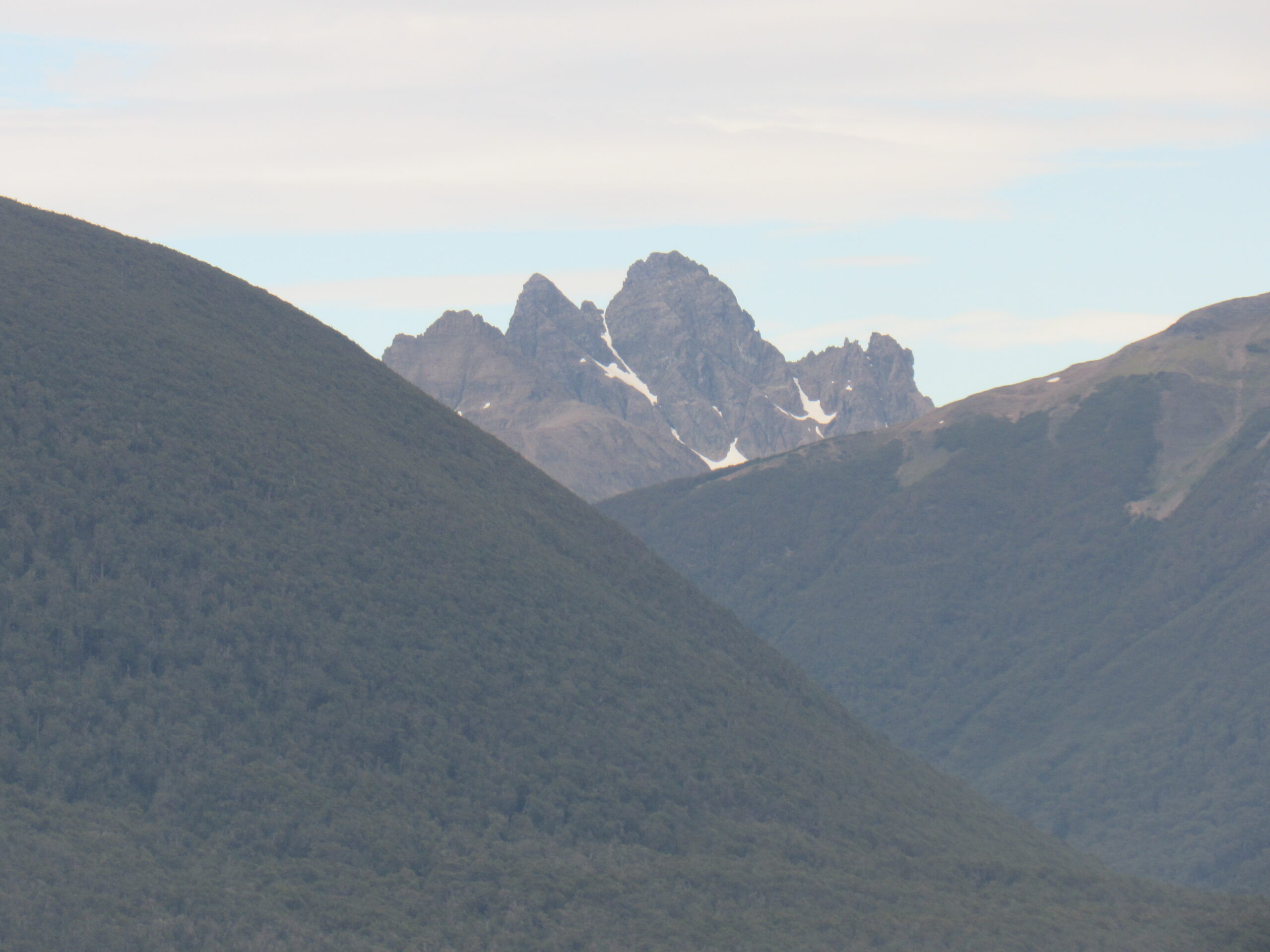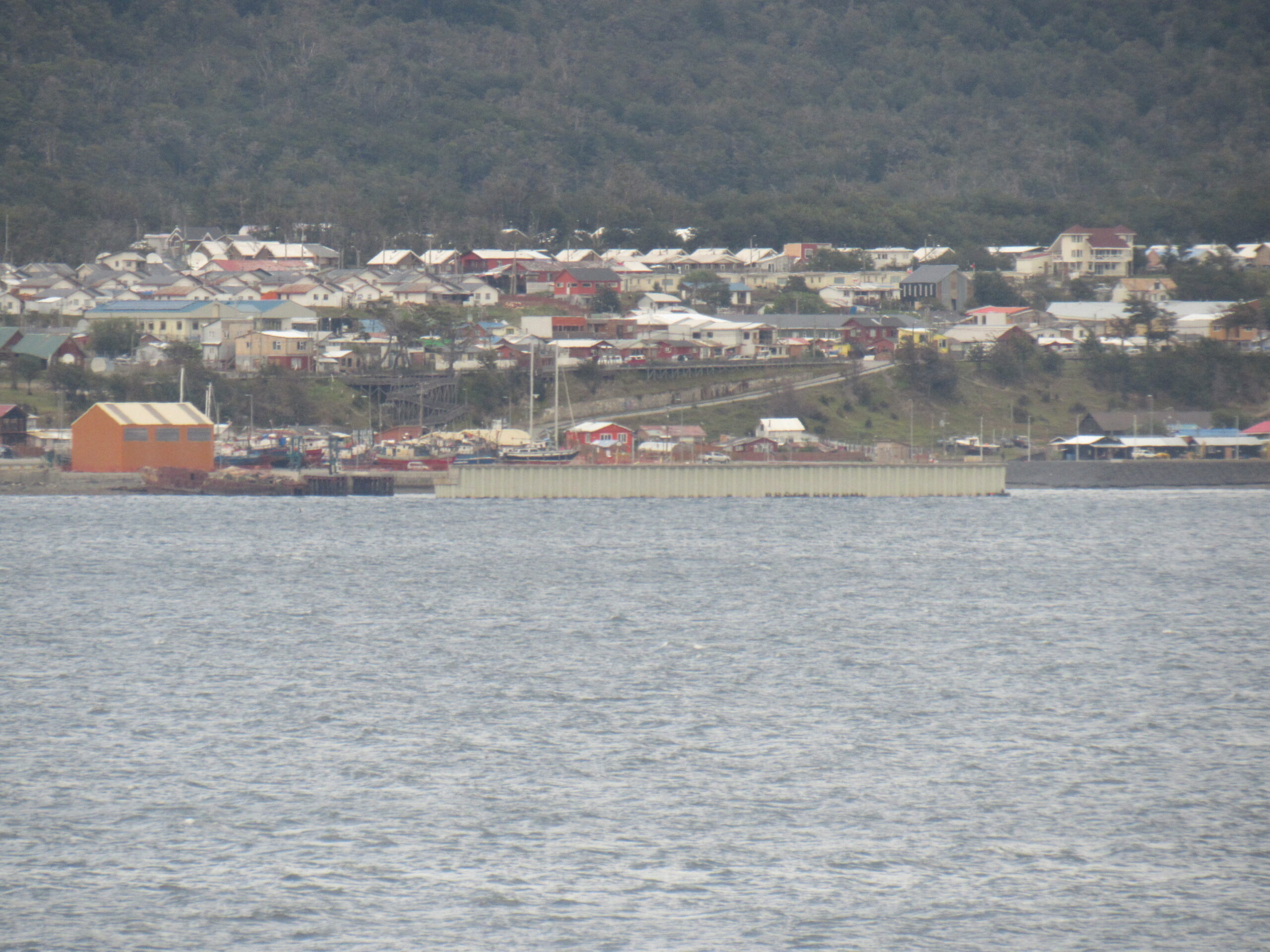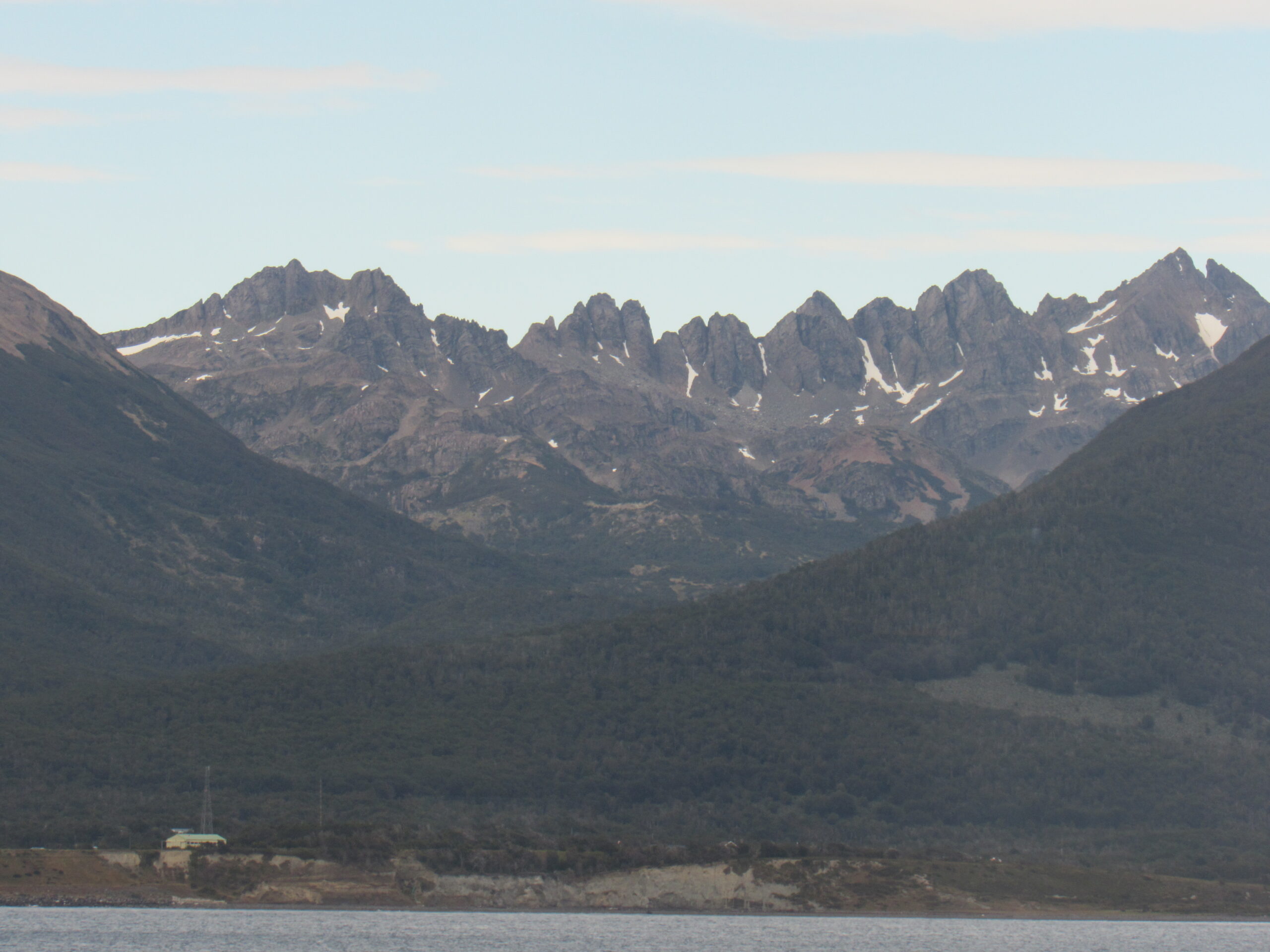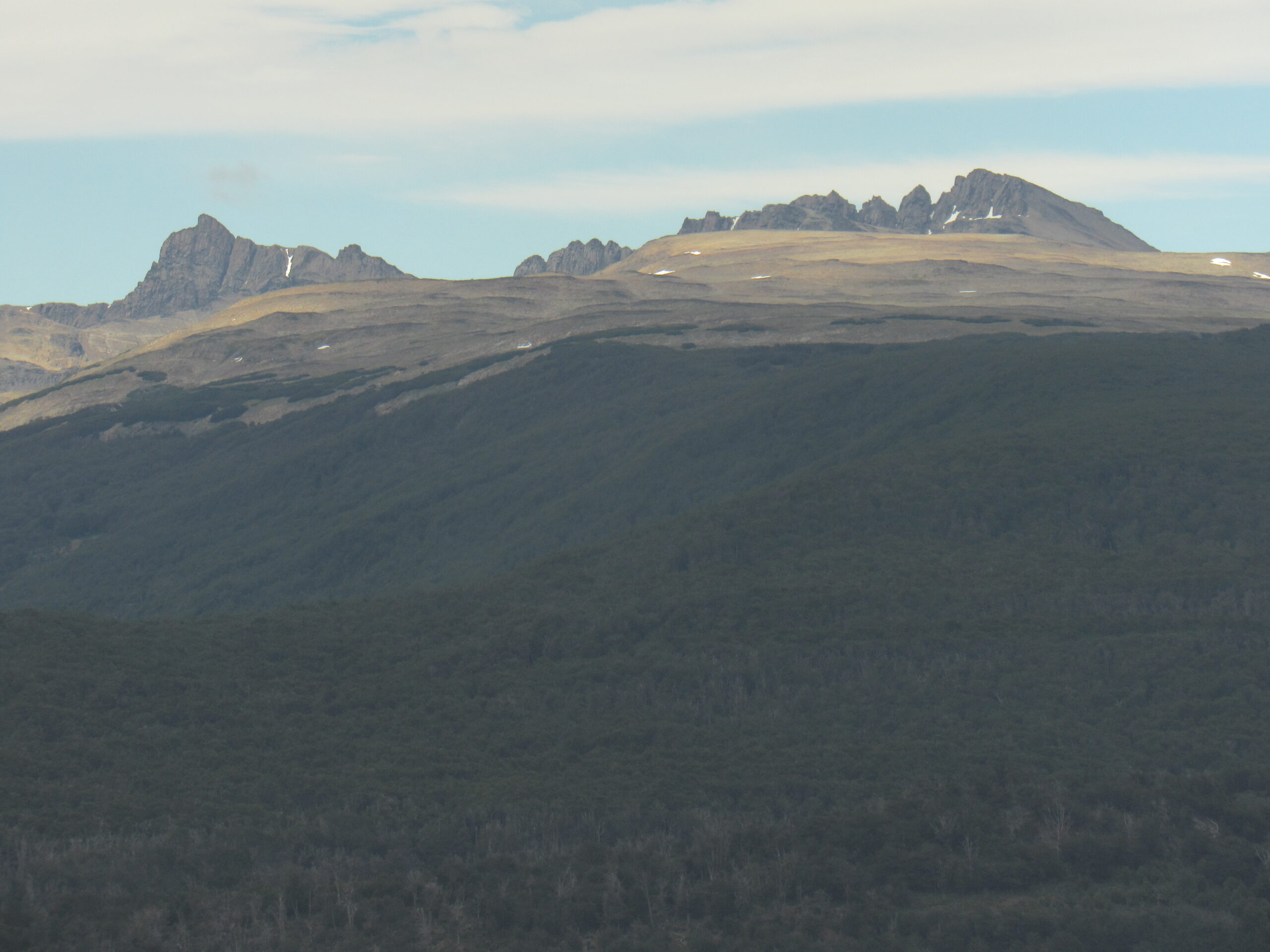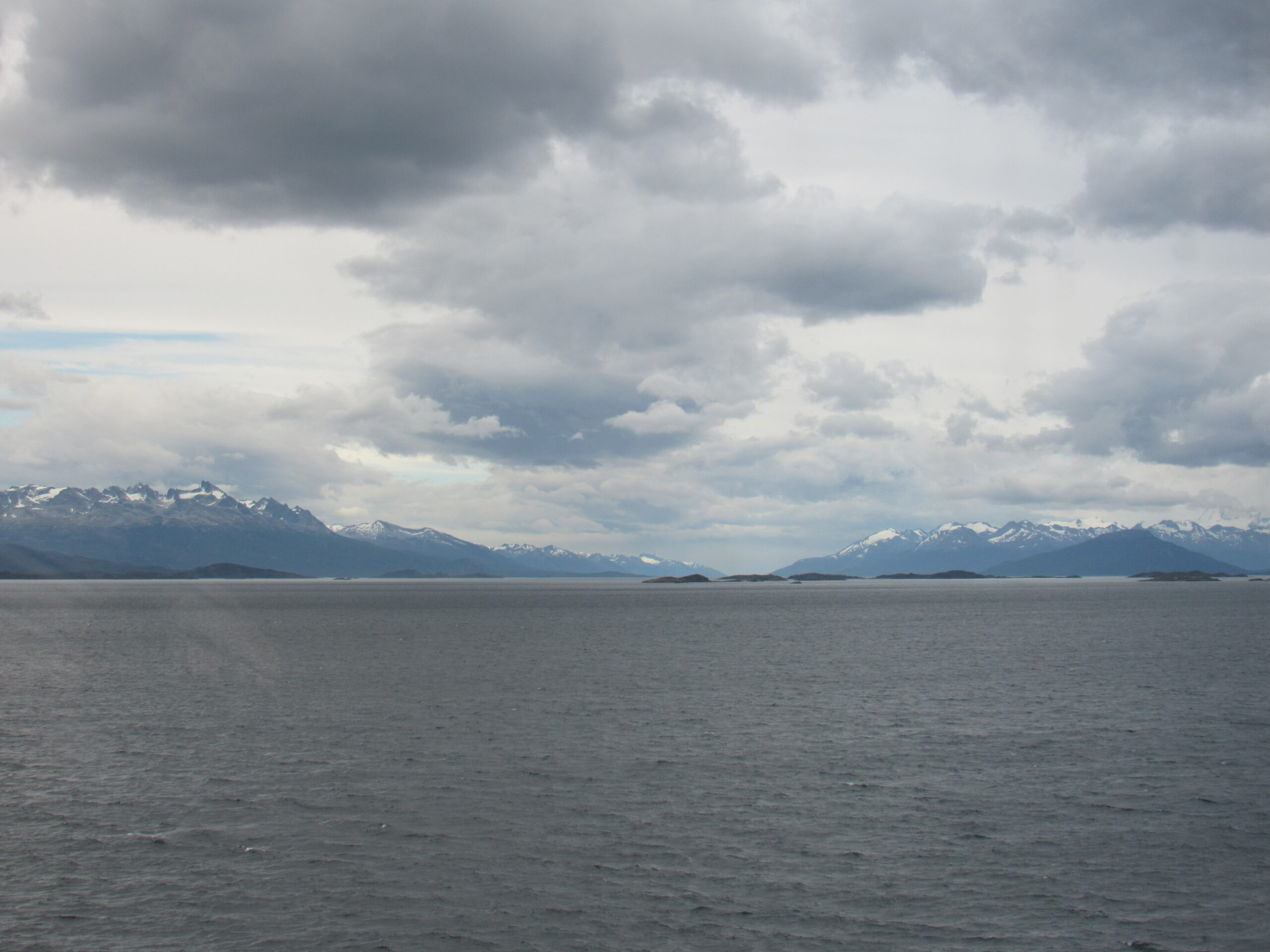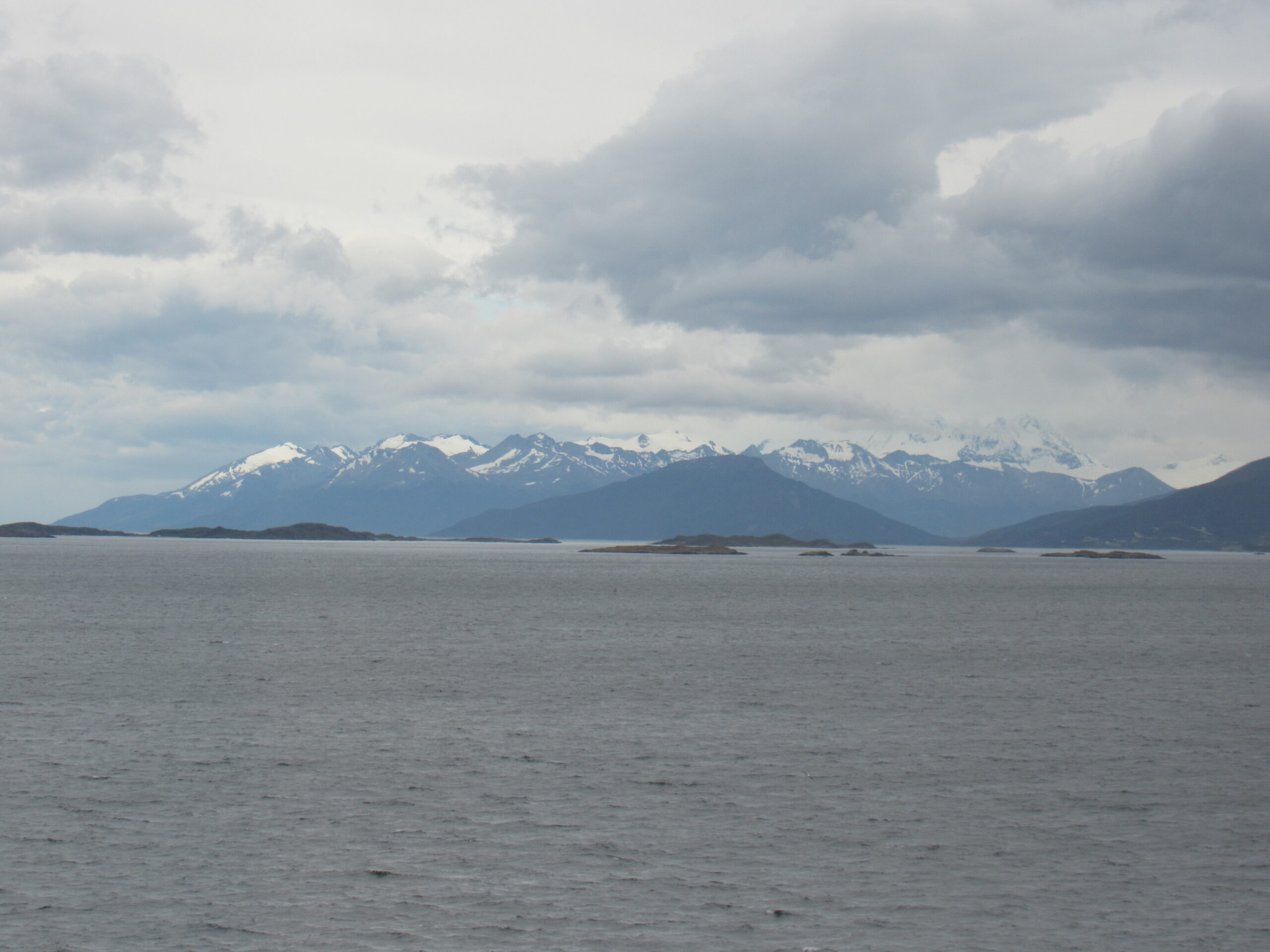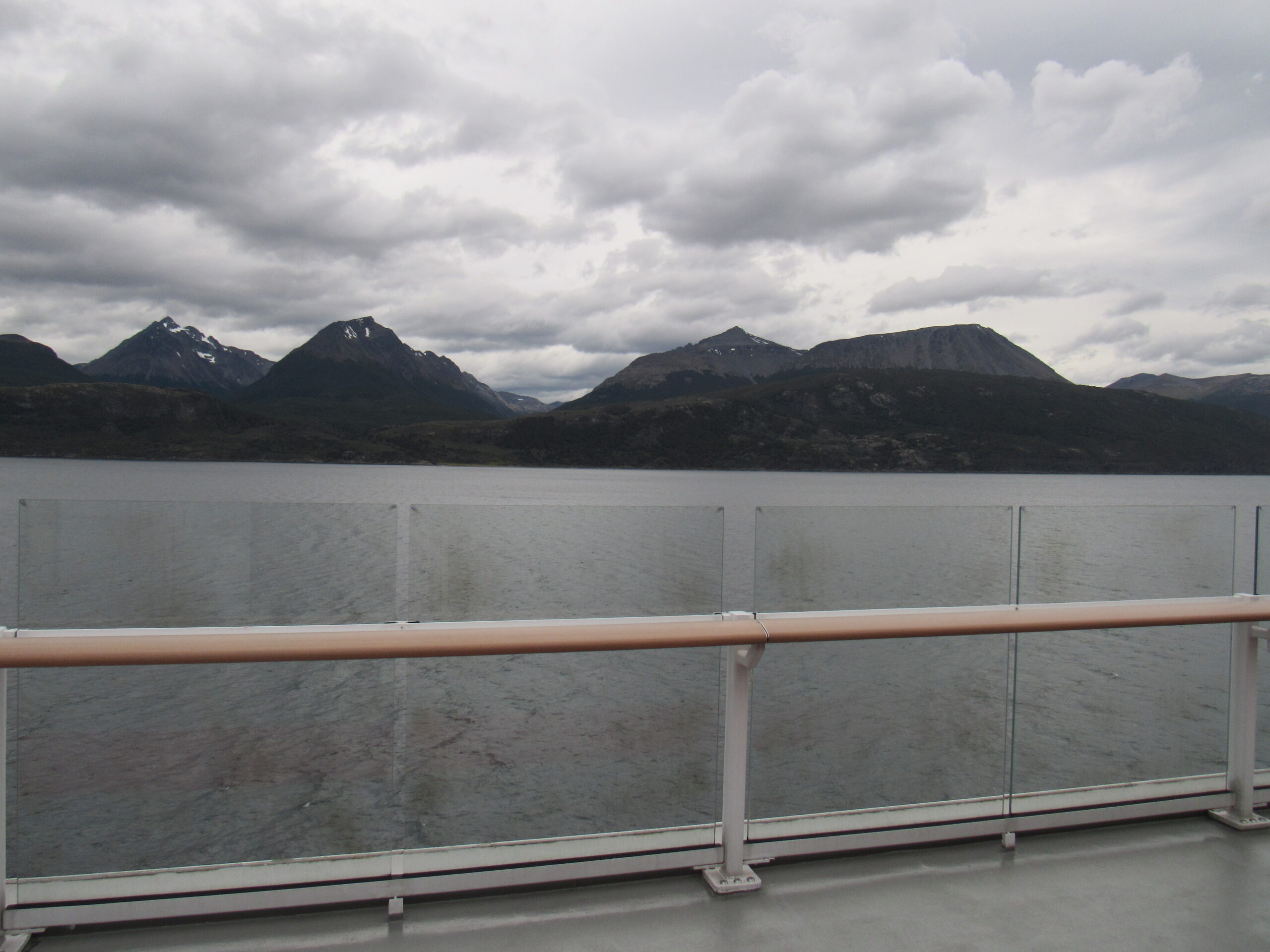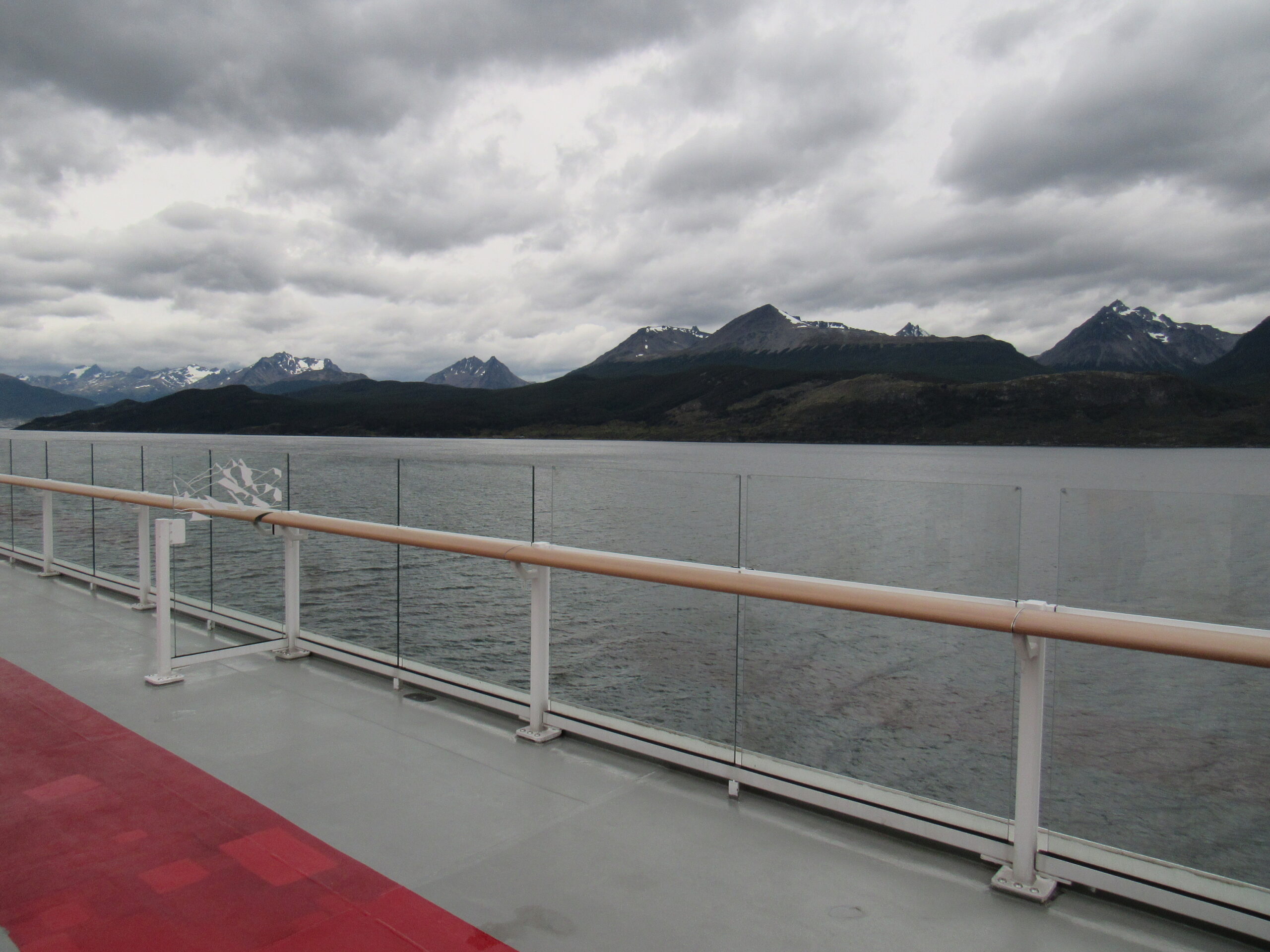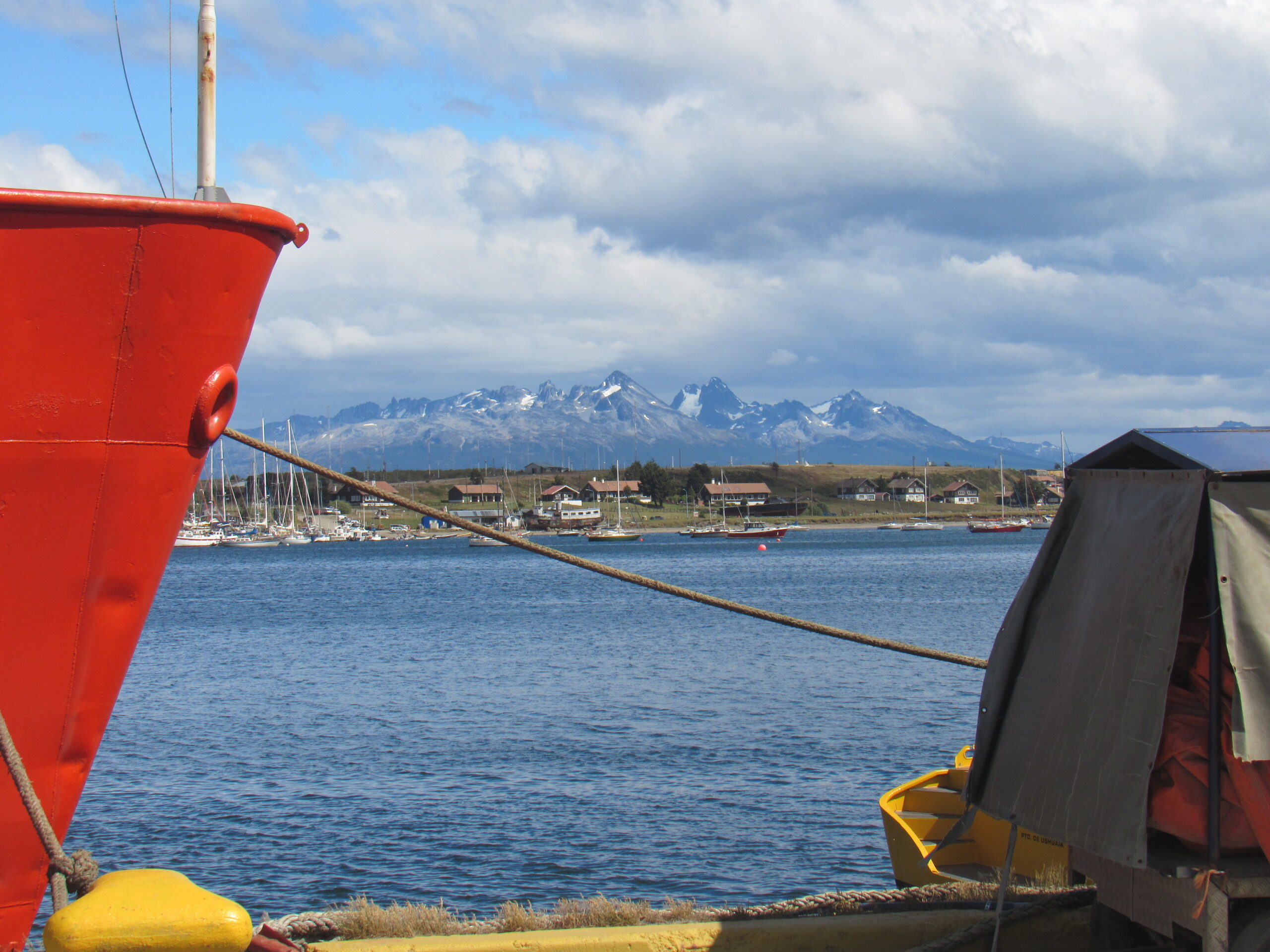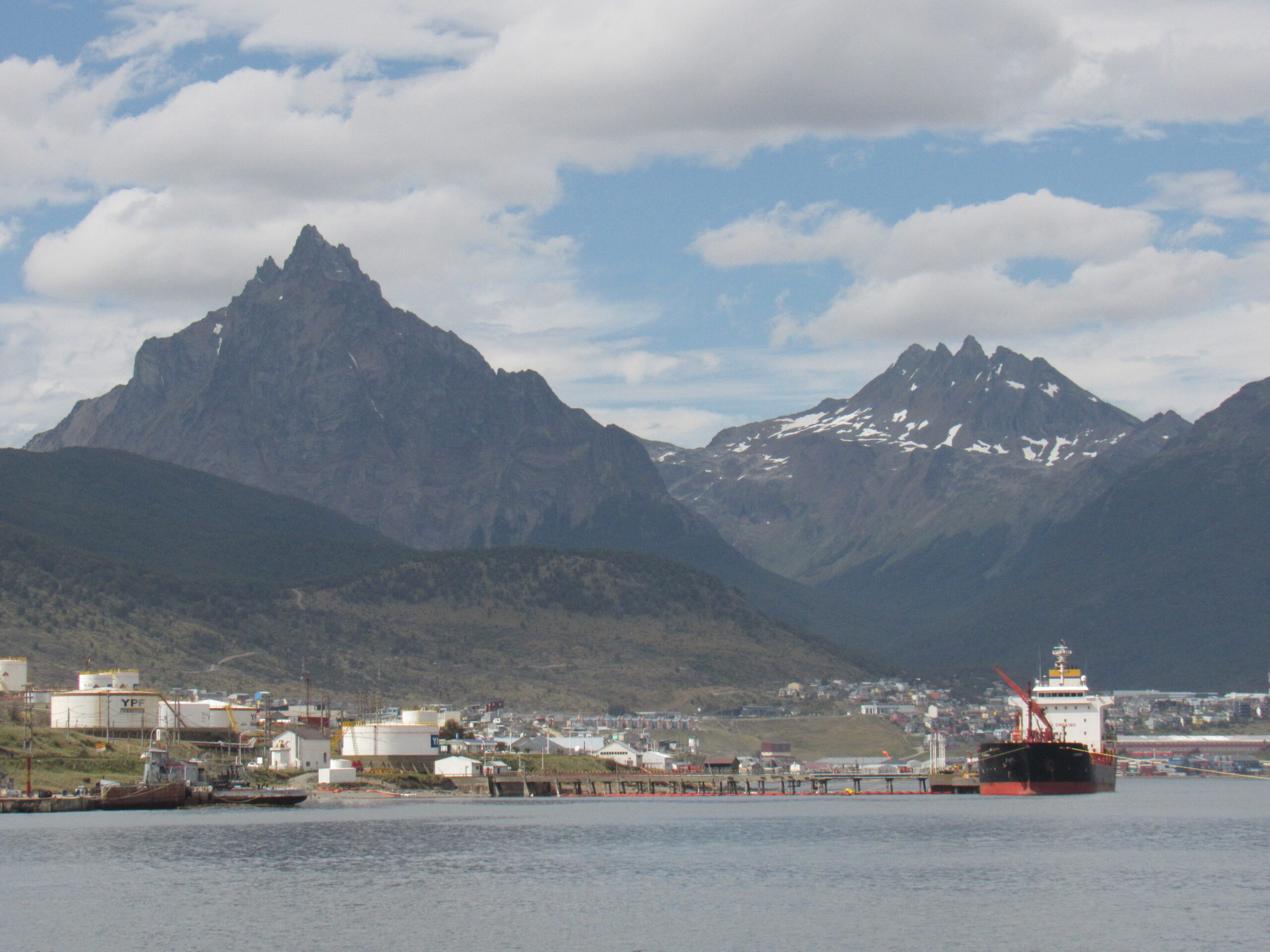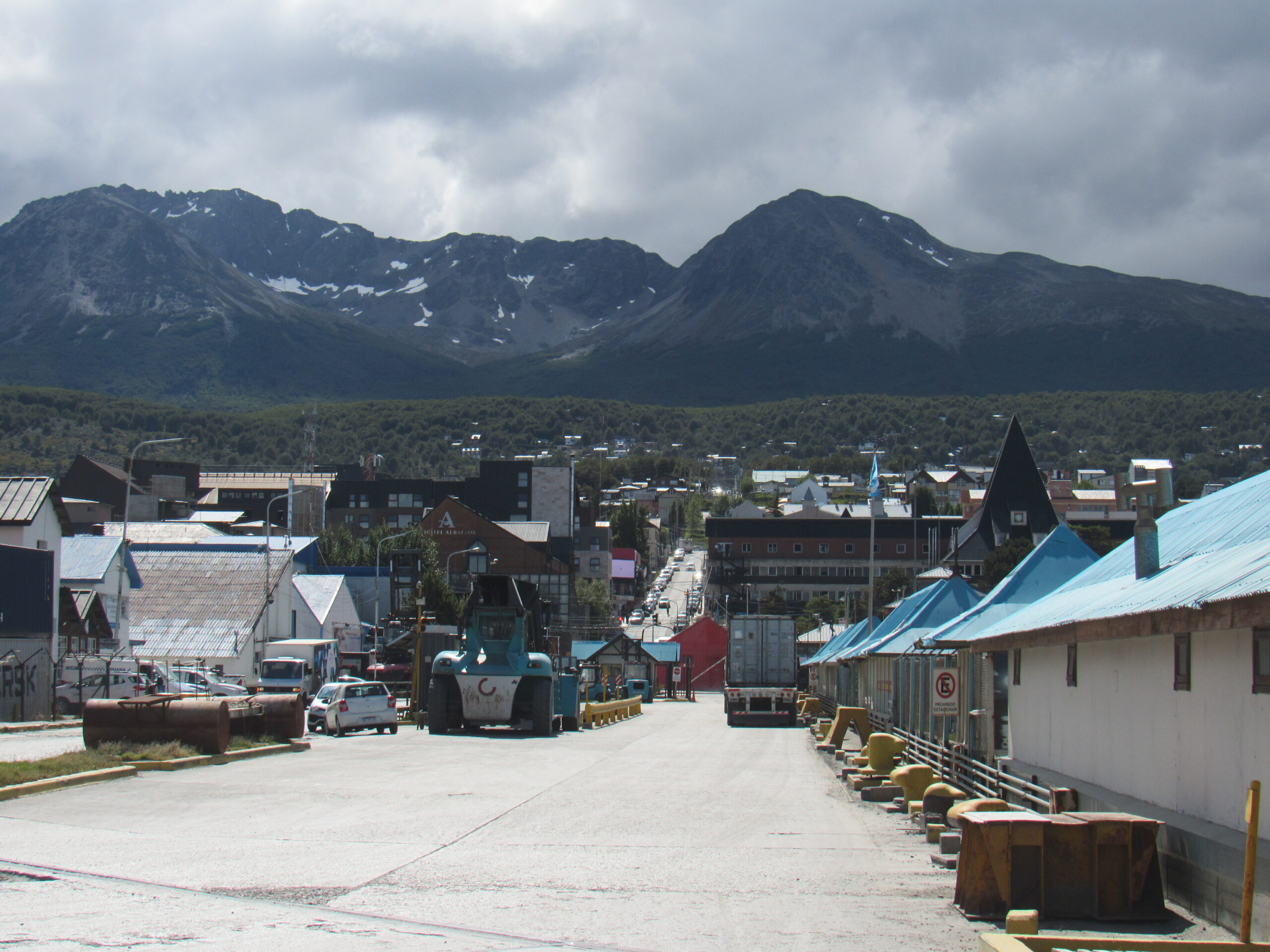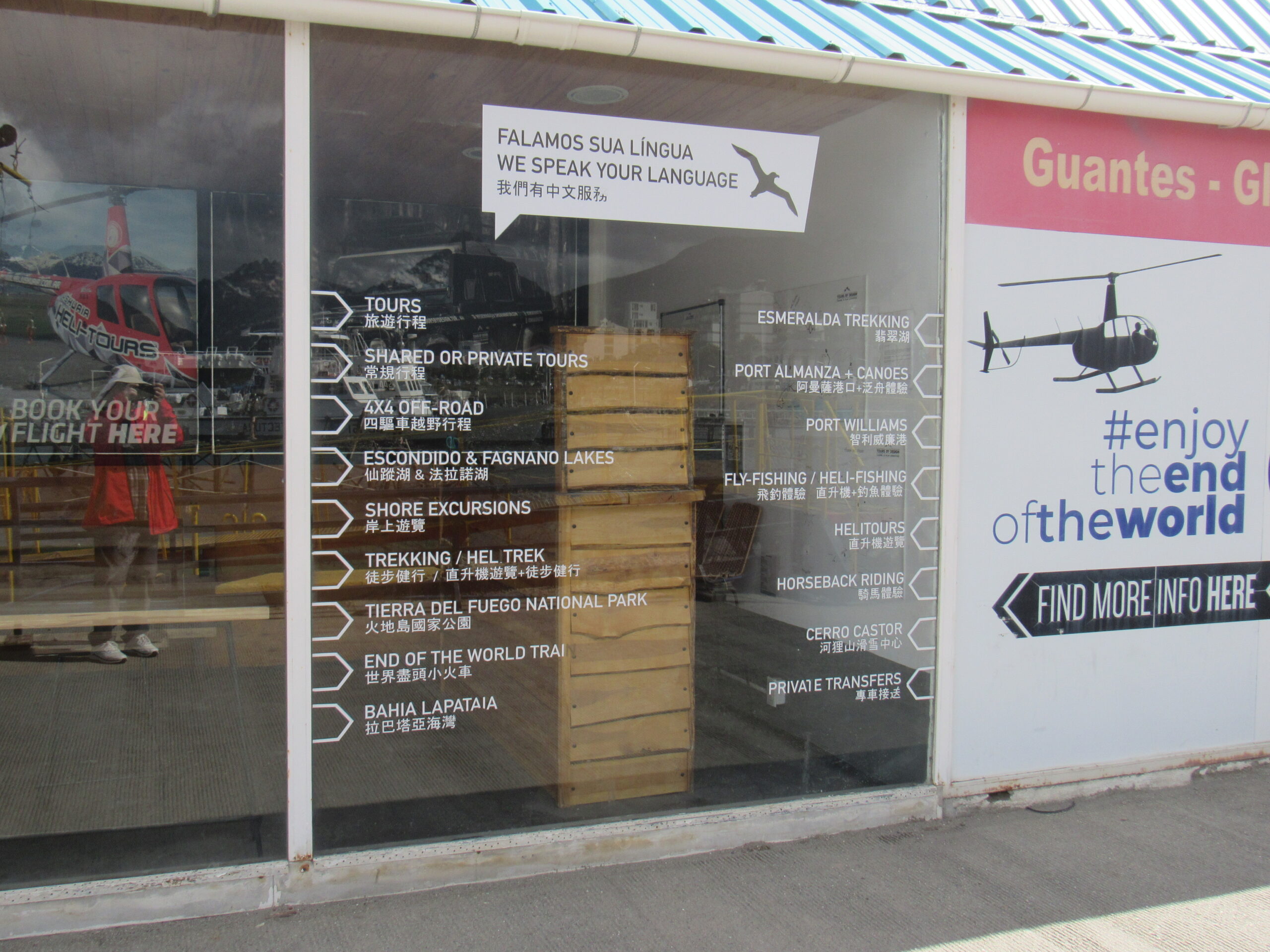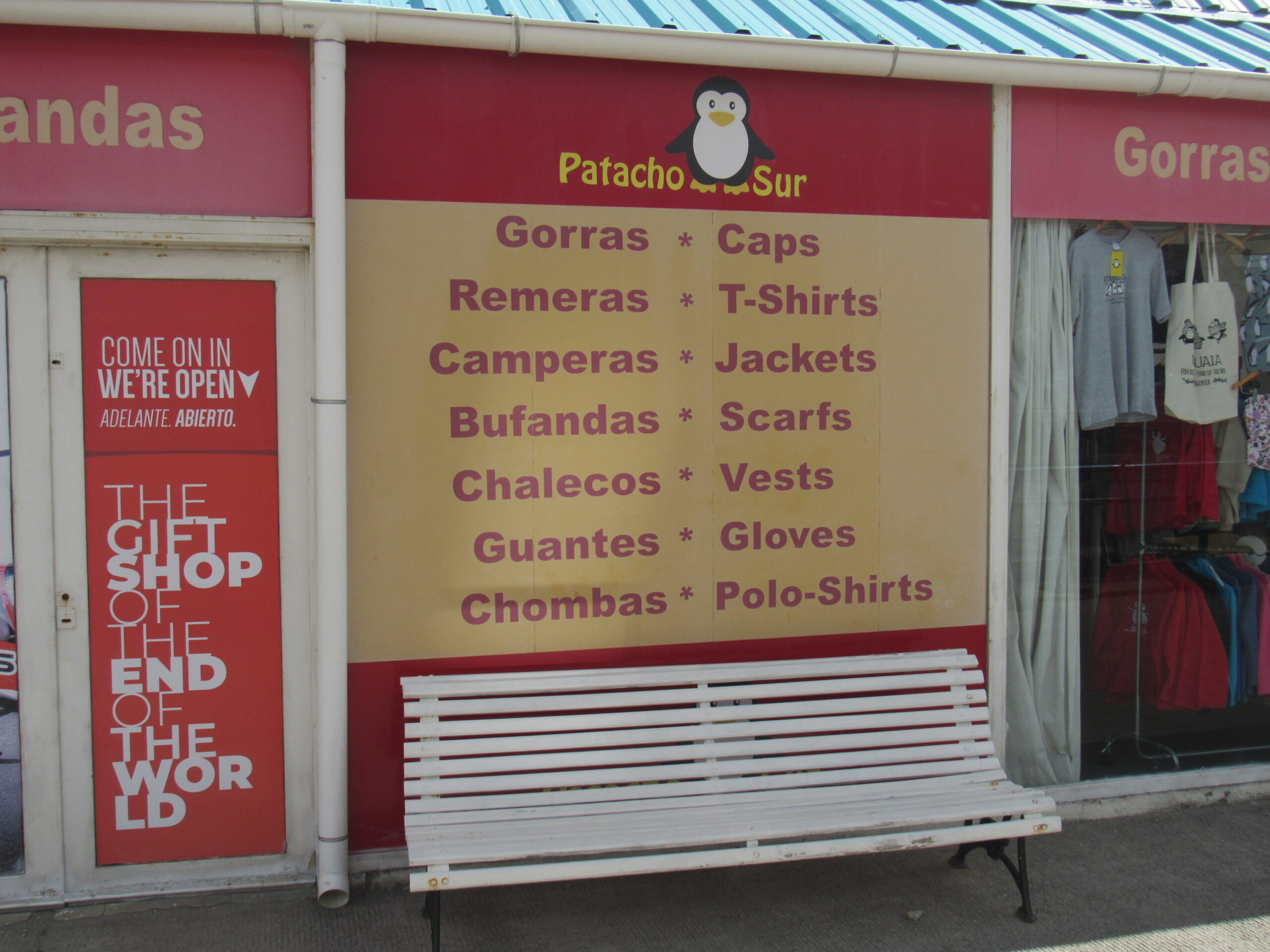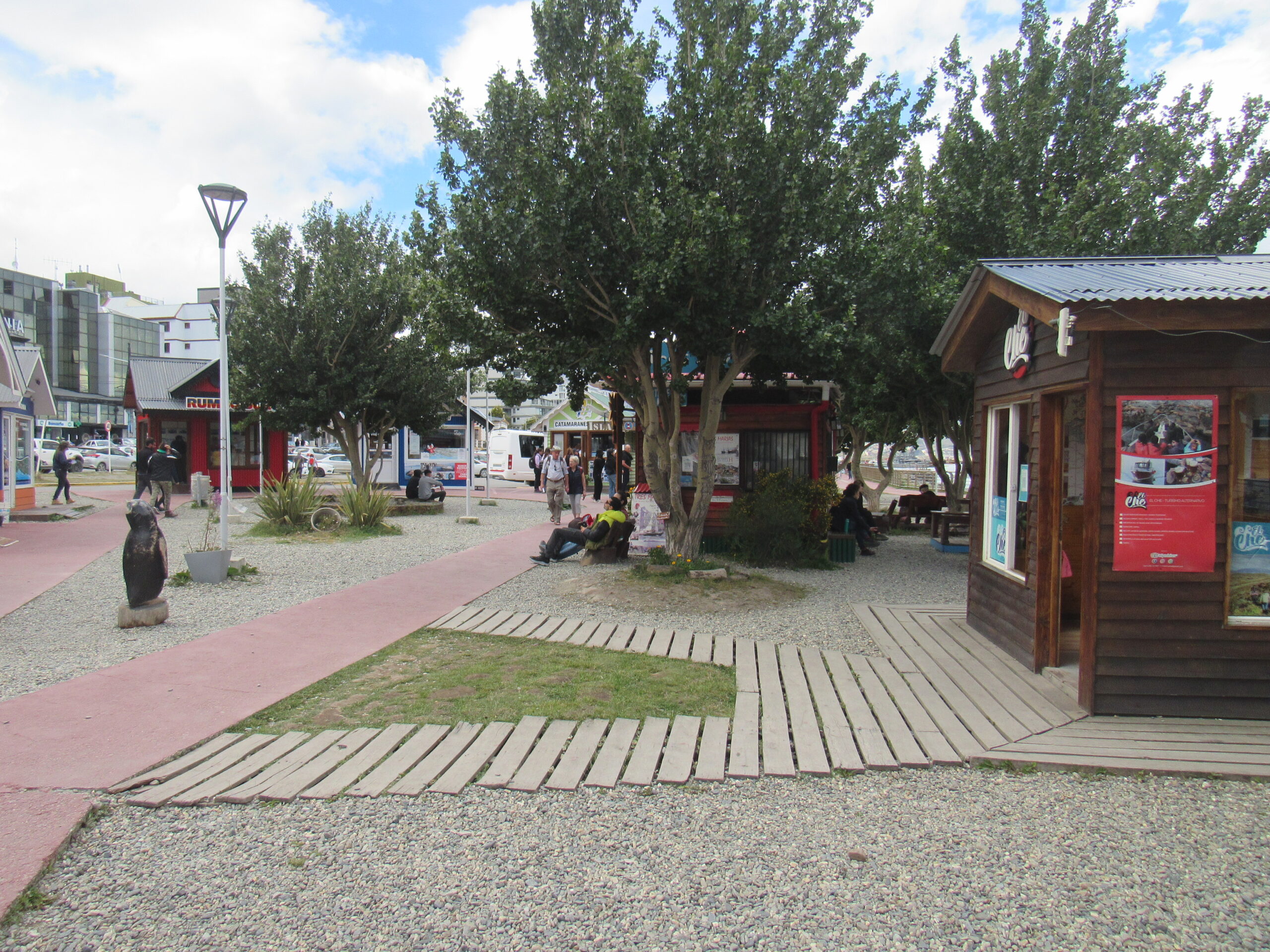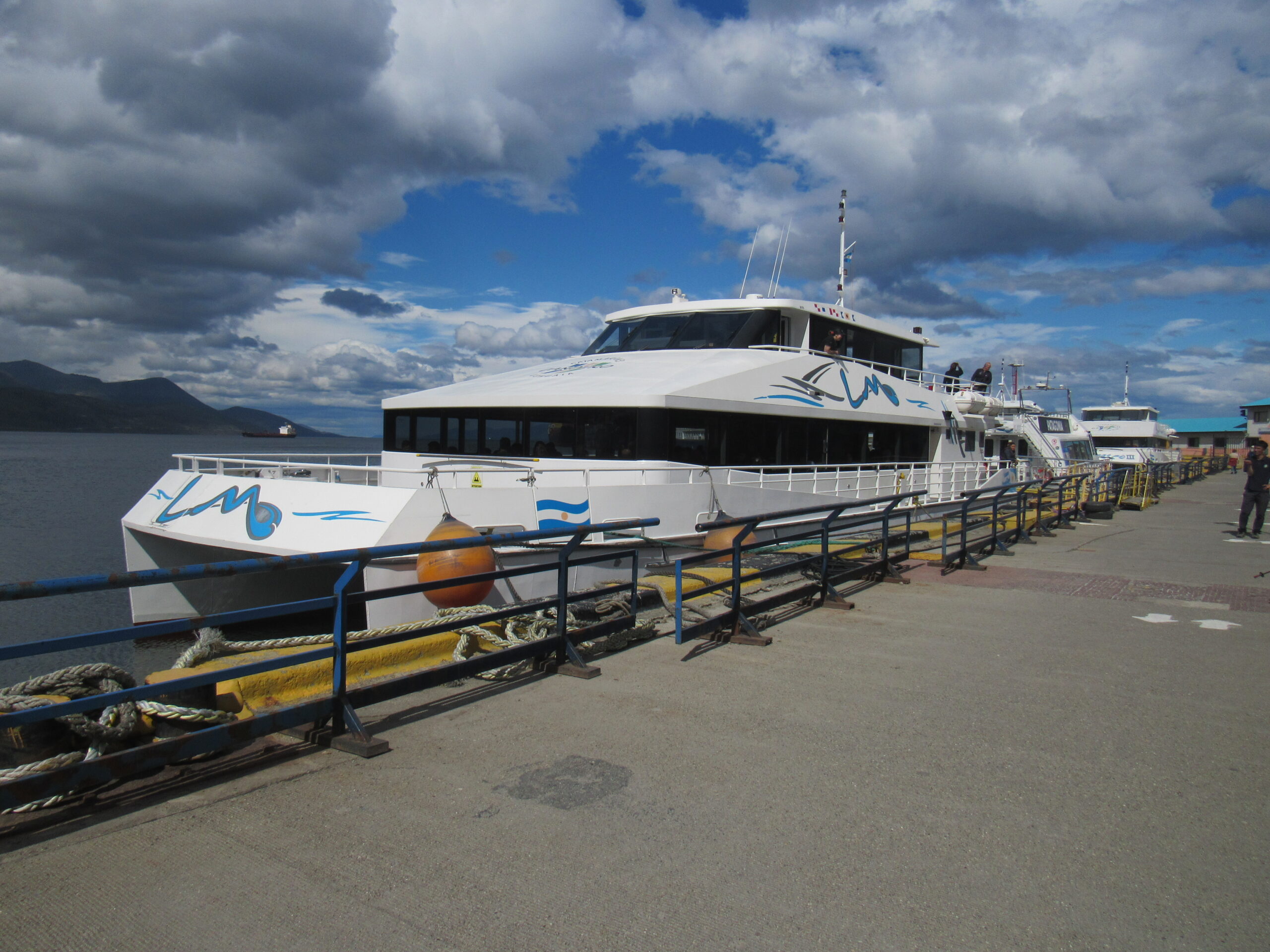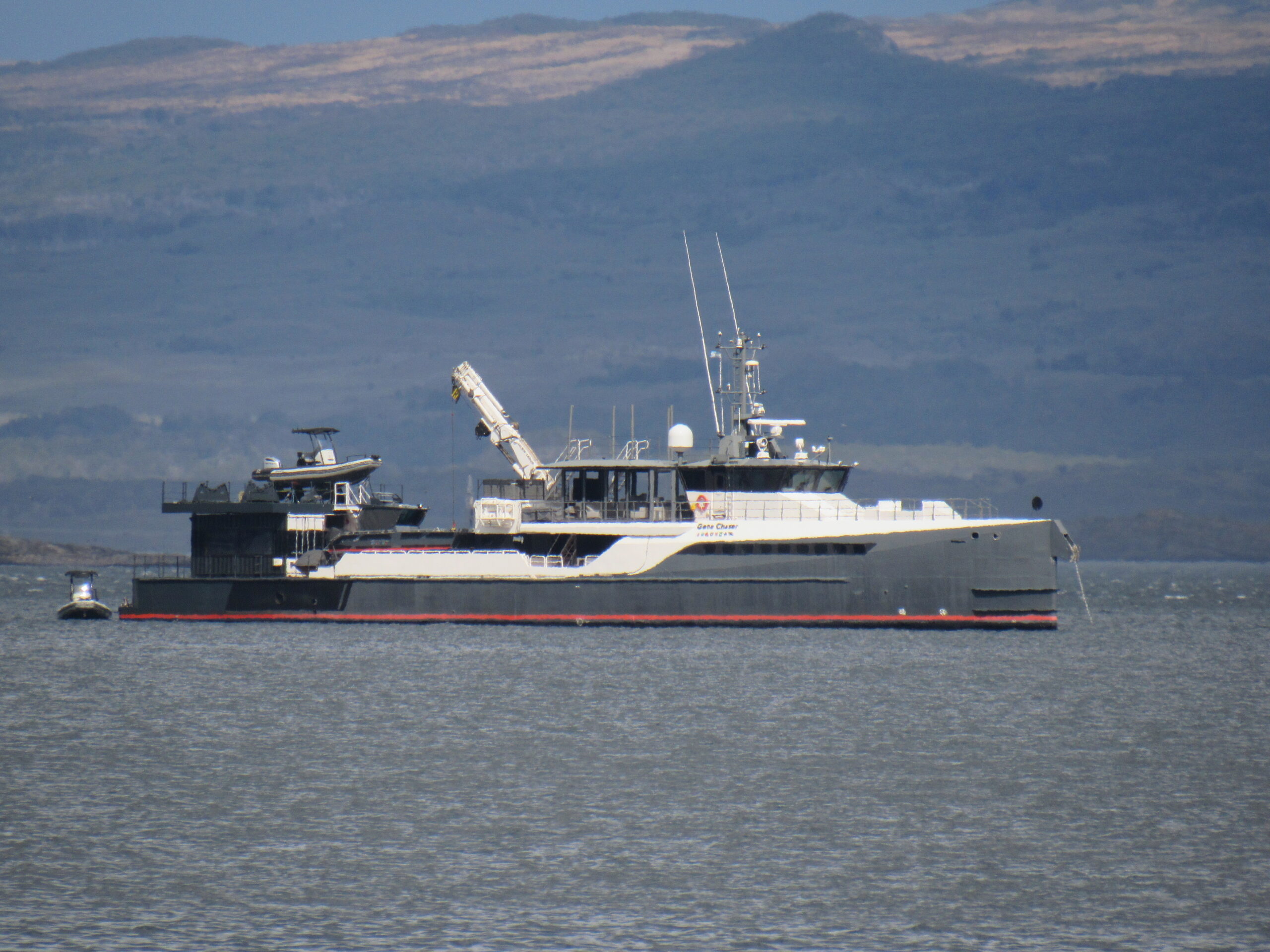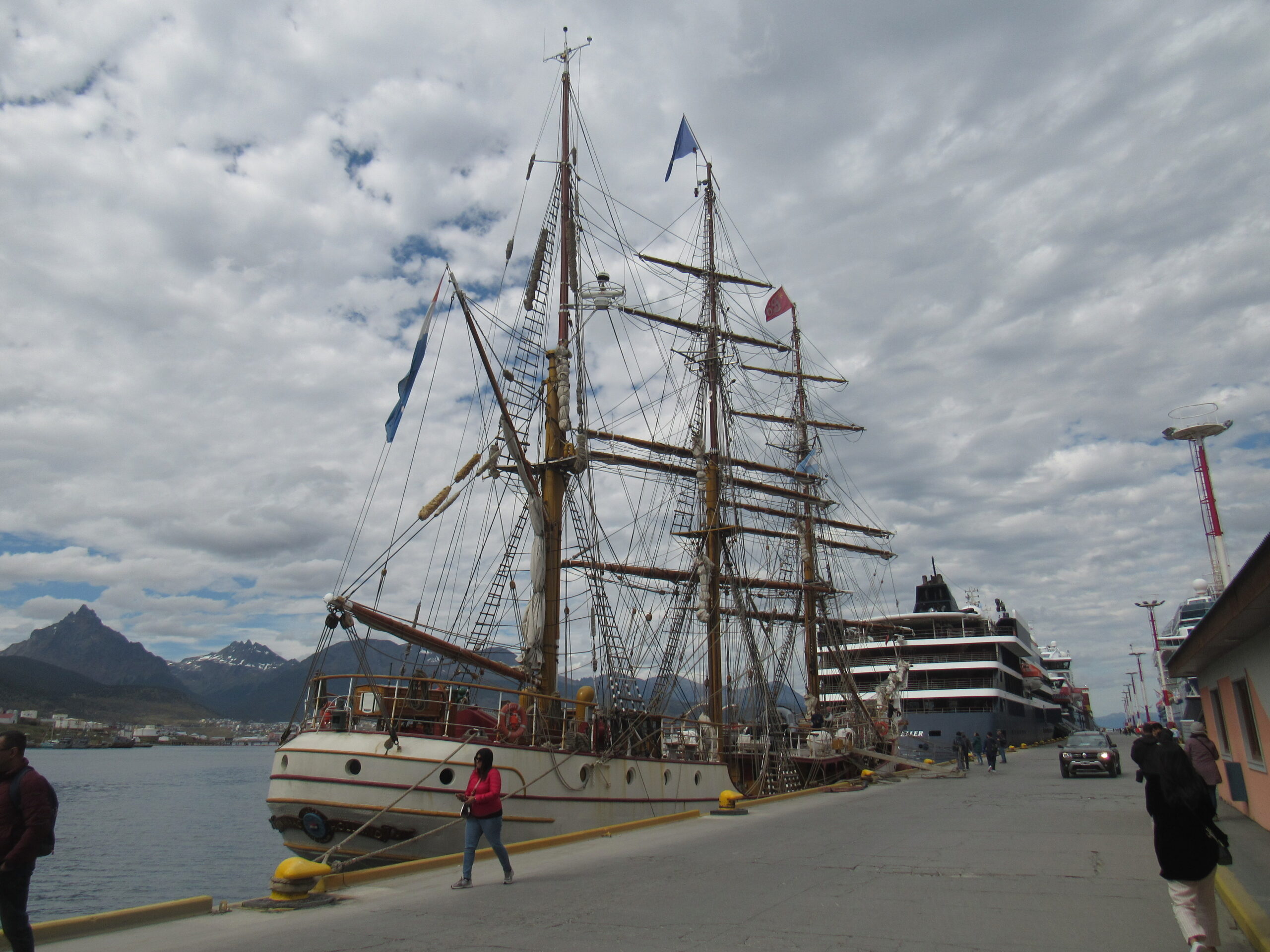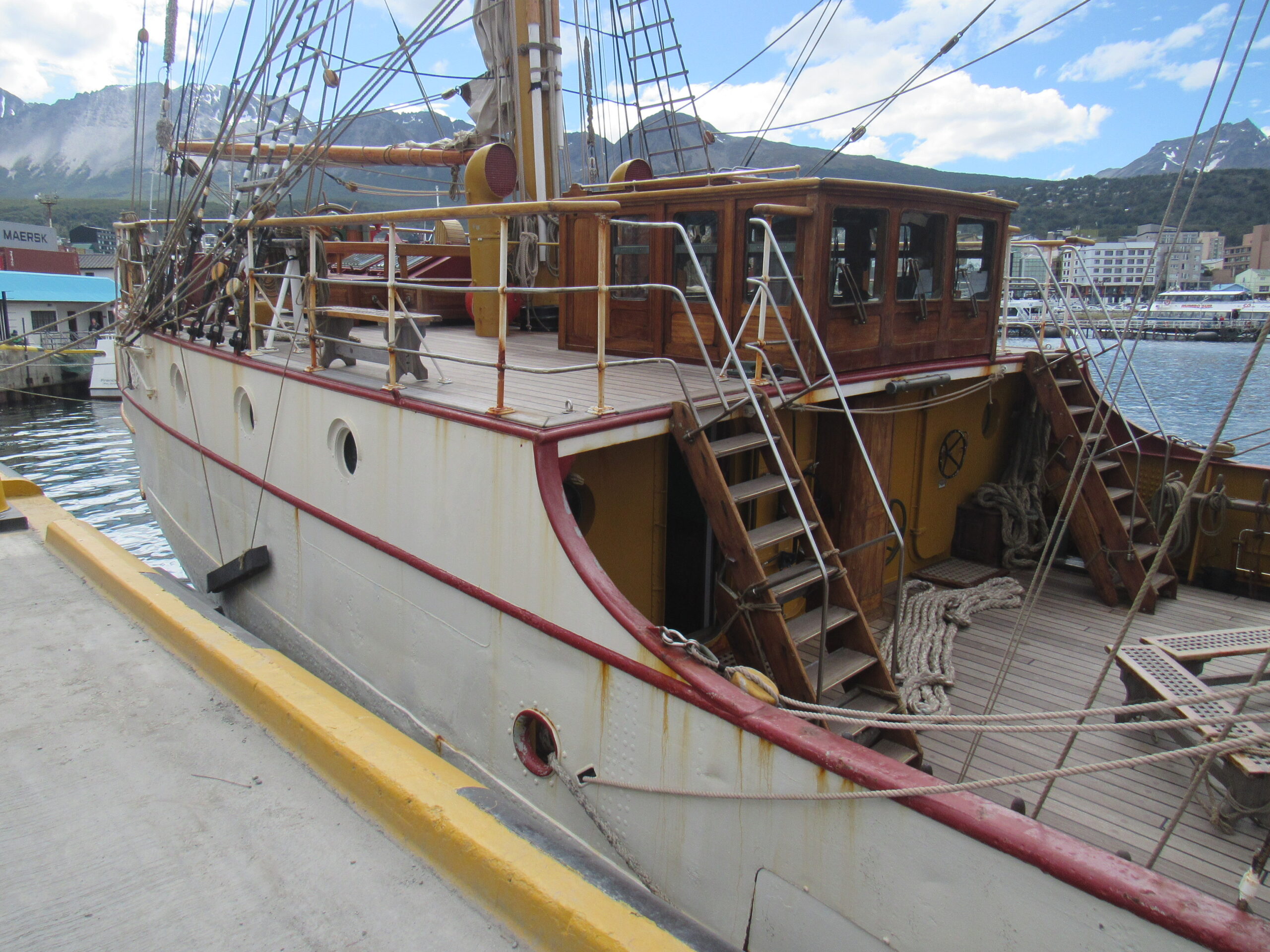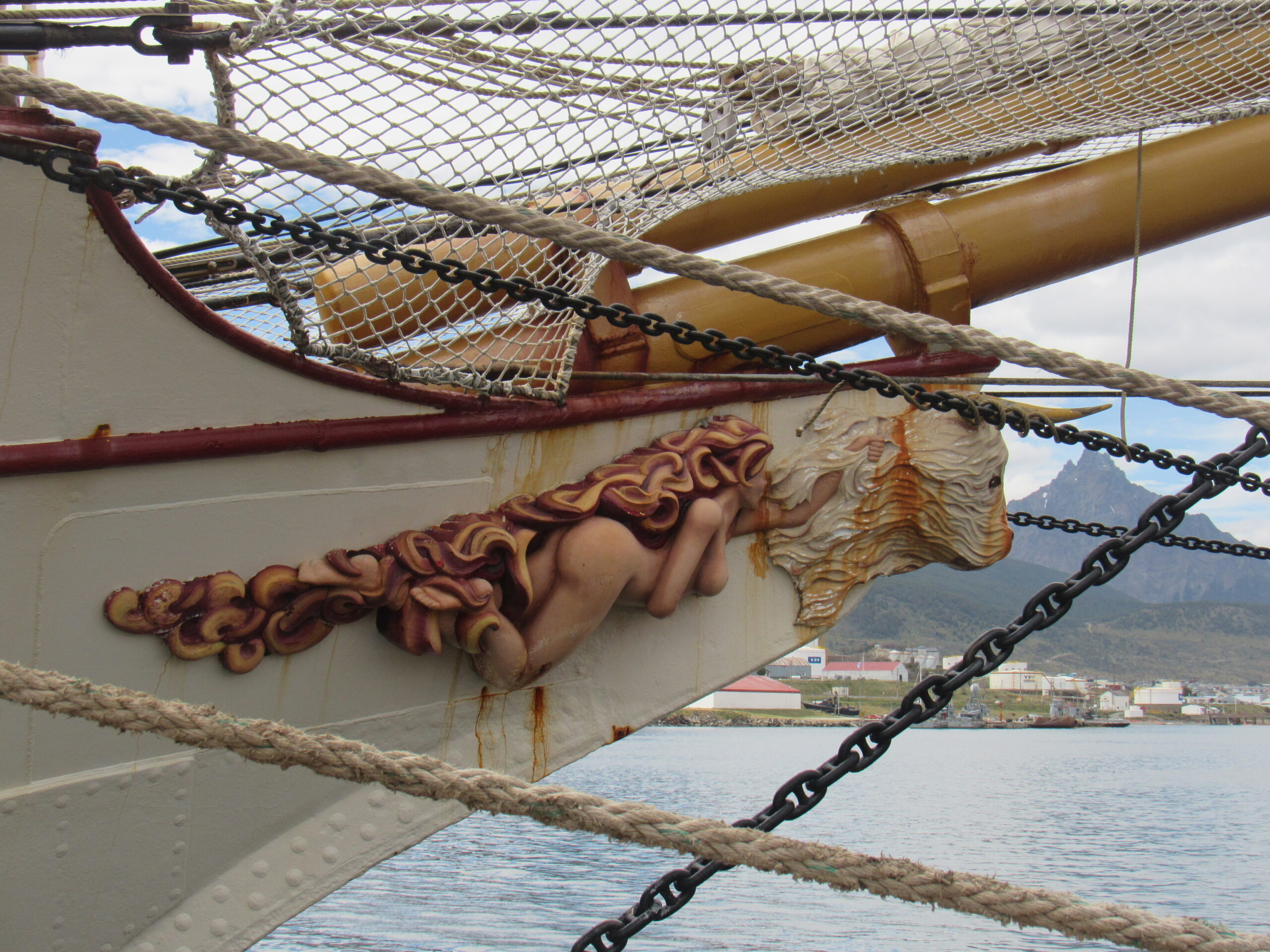It was Sunday, January 21st. We had spent the day at Half Moon Island, and by the time everyone was back on board, it wasn’t until around 4:00 PM that our ship was able to leave. The captain had warned us once again that if we were prone to motion-sickness, we should start taking medicine for it, as we would be entering the Drake Passage soon. I’m a big fan of Dramamine, so I dosed up early.
Remember way back at the end of Chapter Four of this story that the ship’s crew had announced that there was a possibility of a general, nationwide strike that could take place on January 24th that would affect all of Argentina? Well, the morning of the 22nd, we learned that the strike was definitely happening. That was bad news for all of the passengers. In a perfect world, our original itinerary had us flying out of Ushuaia early on the 24th and getting back to the Buenos Aires airport around noon that day so we could catch our connecting flights home, but now that wasn’t happening.
Hurtigruten was most willing to help us. They said we would stay in port all day on the 24th and also overnight, then fly to Buenos Aires on the 25th, one day later than the original plan. There would be no extra charge to us passengers for the extra day and night on board, so that was one less thing to worry about. However, we all still needed to arrange for new flights to replace the ones we were about to miss because of the strike.
By 5:00 PM, the ship was starting to roll very noticeably. These modern ships have high-tech stabilizers, but even those have their limitations. After dinner that evening, up on Deck 10, members of the crew put on a concert for everyone. They had instruments, amplifiers and speakers, and played a lot of rock oldies that everybody knew, regardless of your country of origin. One of the women was a good singer and had us all singing along with her, and many passengers and crew were dancing. It was a fun time, and by the time I returned to my cabin and turned in, the rocking of the ship had picked up even more. Wisely, I took a second Dramamine and had a good night’s sleep.
The next morning, Monday the 22nd, I realized I had to get serious about arranging a new flight home. After taking another Dramamine, I sent an email to my travel agency, but they were taking too long to get back to me and I was becoming concerned that I was running out of time. The reception desk had told us that they would help us in any way they could, so I went to see them. They offered to place a satellite phone call for me, so I sat at a comfortable desk in their office and waited half an hour on hold for the travel agent to come on the line. When they finally did, I told them that I needed a new flight to replace the one I would miss due to the strike. I told them that I was out in the middle of the Southern Ocean on a ship near Antarctica and was absolutely depending on them to come through for me. They said they’d arrange a new flight for me, probably the same one I would’ve been on but 24 hours later. Later in the day, they contacted me by email to say that it had been arranged, and I needed to pay an extra $2,232.00 US dollars for the replacement flight, nothing that my credit card couldn’t take care of. I was much relieved that I now had a new flight home.
That same day, I settled my ship’s account for the few expenses I had racked up while on board. Dinner that evening was quite dramatic – the crew had a difficult time serving us, the ship was moving about so much, at times almost violently. I guess they were experts at dealing with such situations, though, especially if they worked the run across the Drake often enough. I heard some dishes smashing, but only a few. Passengers who waited too long before taking seasick meds were in a bad way. The winds outside were blowing at times up to 85 miles per hour, and waves were 35 feet high. This rated a 10 on the Beaufort Scale, which put it at hurricane force, yet the captain described the weather outside as just “moderate” for the Drake Passage. Man oh man, I’d hate to experience a rough day! This video gives an understated idea of what was going on outside.
A tour of the engine room taught us that all of the water used on the ship was sea water that was purified onboard. The ship also purified our waste water before pumping it back into the ocean. The 850 million US dollars spent to build the ship had resulted in some of the greenest features to be found on any cruise ship anywhere.
That night, it was quite an experience lying in bed and trying to fall asleep. The ship at times rolled strongly, making it tricky to lie in bed, and sometimes a loud bang indicated a big wave had hit us hard. Not a boring night, to put it mildly.
The next morning, we awoke to calm seas, having crossed the Drake and entered the quiet waters of the Beagle Channel. We were on the home stretch, as it is only about 70 miles from the eastern end of the channel to Ushuaia, but this would still take us a few hours. After some breakfast, I headed up to Deck 10, the best and most comfortable place indoors to get a good all-around view of our surroundings. Years ago, I had spent time on the north (Argentine) side of the channel, so today I wanted to focus on the south (Chilean) side. I’d have a chance to see some interesting things for the first time.
Isla Navarino dominates the south side of the channel – it lies totally within Chile and, at 970 square miles, is the 4th-largest island in the entire vast Tierra del Fuego archipelago. It’s main claim to fame is the Chilean naval base, a town called Puerto Williams. A road runs east from the town for 14 miles and ends at Eugenia Cove, and the same road (Y-905) runs west for 34 miles to end at Puerto Navarino, a small port directly across the channel from Ushuaia. So this road extends all the way across the north side of the island, but other than that, the island is entirely wilderness. In the interior of the island are the Dientes de Navarino, which rise to a height of 3.921 feet. Here was our first glimpse of those striking peaks.
We sailed along the length of the town, and here is a typical view of what it looked like.
Back in 1990, during my last visit to Ushuaia, I wanted to visit Puerto Williams, but couldn’t get there to save my life. I was told a boat made the trip once a week, but even then it would be cancelled if not full. Now, in 2024, because tourism had increased so much, there were a number of operators who made the trip daily.
Here’s a better view of Los Dientes.
It looks like a gentle approach to the high country, but that austral vegetation down low proves to be a nasty bushwhack – I know, I’ve done it.
As we approached Ushuaia, I had these views west down the Beagle Channel. This one is farther to the south.
And this one. It is looking west into the Cordillera Darwin.
Every time I’ve been in this area, the Cordillera Darwin has been shrouded in cloud, much to my disappointment. The highest peaks, Monte Darwin (8,400′) and Monte Shipton (8,500′) are world-class mountaineering challenges, draped in glaciers which drop all the way to the ocean. Monte Darwin sits a mere 55 miles west of Ushuaia.
As we neared Ushuaia, this is the aspect seen on the north side of the channel, the Argentine side.
At around noon, we docked at Ushuaia to clearing skies, a bright welcome from the stormy seas we had traversed. Have a look at this next photo.
Only 10 miles distant, you see the rugged peaks of Isla Hoste, the second-largest of the many hundreds of islands that make up the Tierra del Fuego archipelago. Be sure to click on the link to learn more about this uninhabited island. There, you’ll see a small map – click on it to blow it up, and you’ll notice the unusual shape of the island. It is comprised of 5 large named peninsulas, and just when you think one of them is ending, a narrow isthmus joins it to another to create the most improbable land shape you’ve ever seen.
I had some lunch, then left the ship and went for a walk. We were berthed with other ships along a pier which was about 1,800 feet long, which I followed to the edge of the city. Here’s a view across part of the harbor to some of the surrounding mountains. The pointed one on the left is Monte Olivia, at 4,350 feet elevation. On the right side of the photo, with the band of snow lower down, is Cerro Cinco Hermanos, at 3,885 feet, so-called because of the 5 bumps along its summit ridge.
Looking along the last of the pier and into the city, you can see how the land slopes upward. Aside from the street that follows the shore, all of the city is built up on to the mountainside, up to as much as 600 feet above the harbor.
The closer you get to the city end of the pier, the thicker the tourist shops become.
Kiosks abounded along the shore, trying to attract tourist business for the sights in Beagle Channel.
With the steady stream of cruise ships coming into port, there were plenty of tourists to snag for these excursions. Large, comfortable boats such as these would regularly take sight-seers out into Beagle Channel to see all of the local sights.
The pier at which our ship was docked had an ever-changing line-up of other vessels, both large and small, such as these:
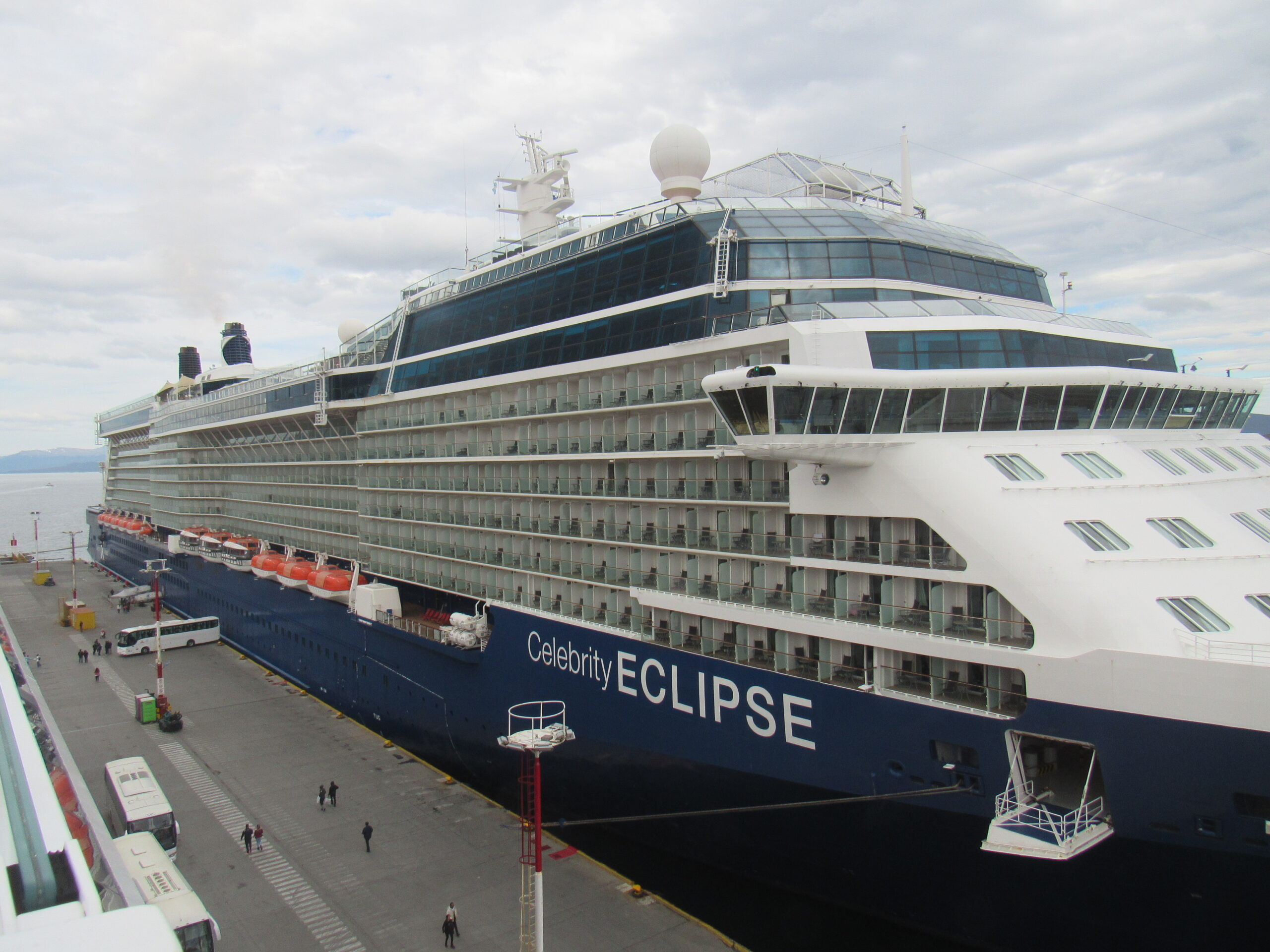
The Celebrity Eclipse. With 2,850 passengers, it was not allowed to take anyone ashore in Antarctica, and I suspect did not go any farther south than some of the South Shetland Islands.
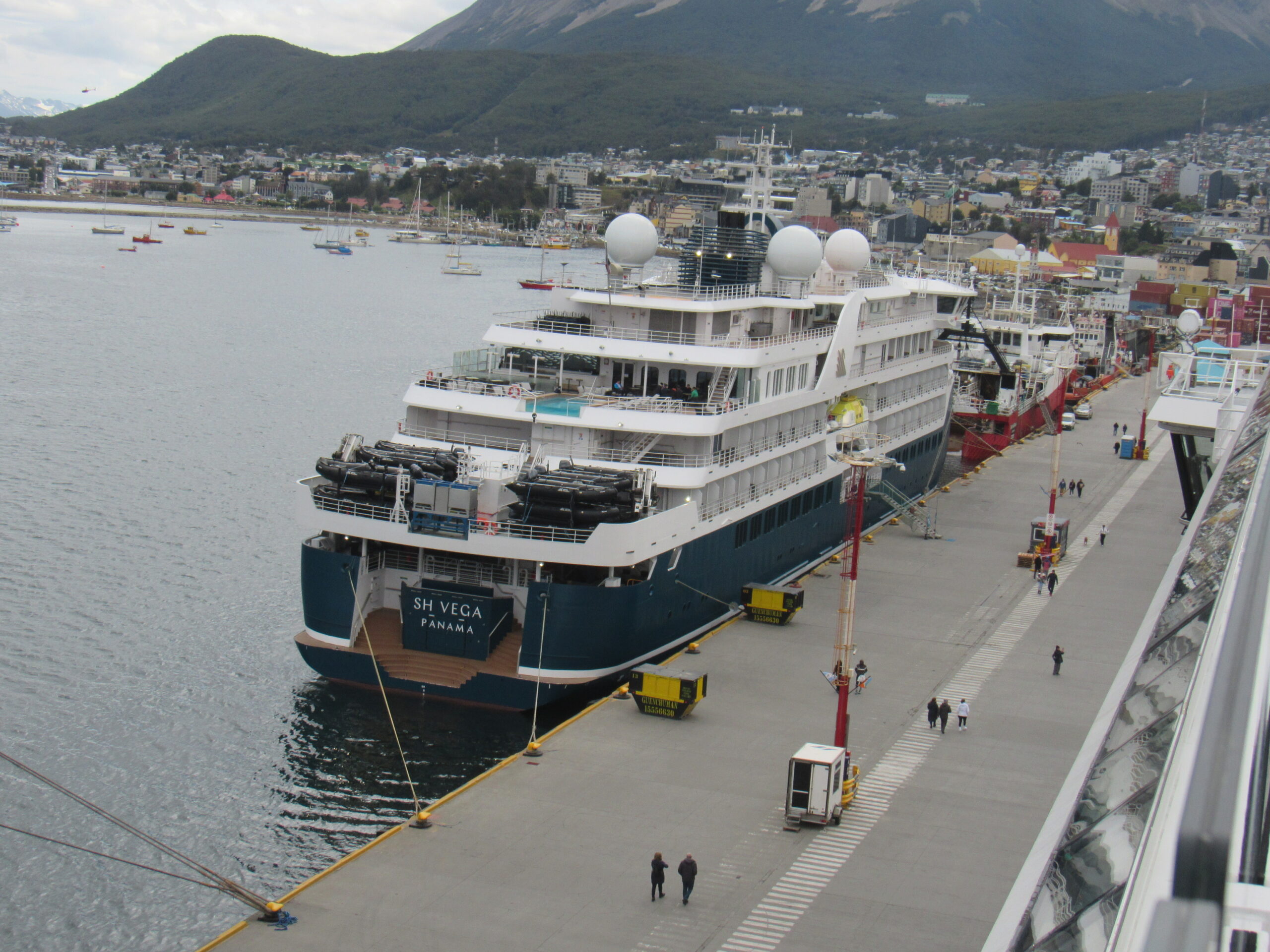
The SH Vega was a small ship with only 152 passengers, and they went as far as the northern tip of the Antarctic Peninsula, so not very far south.
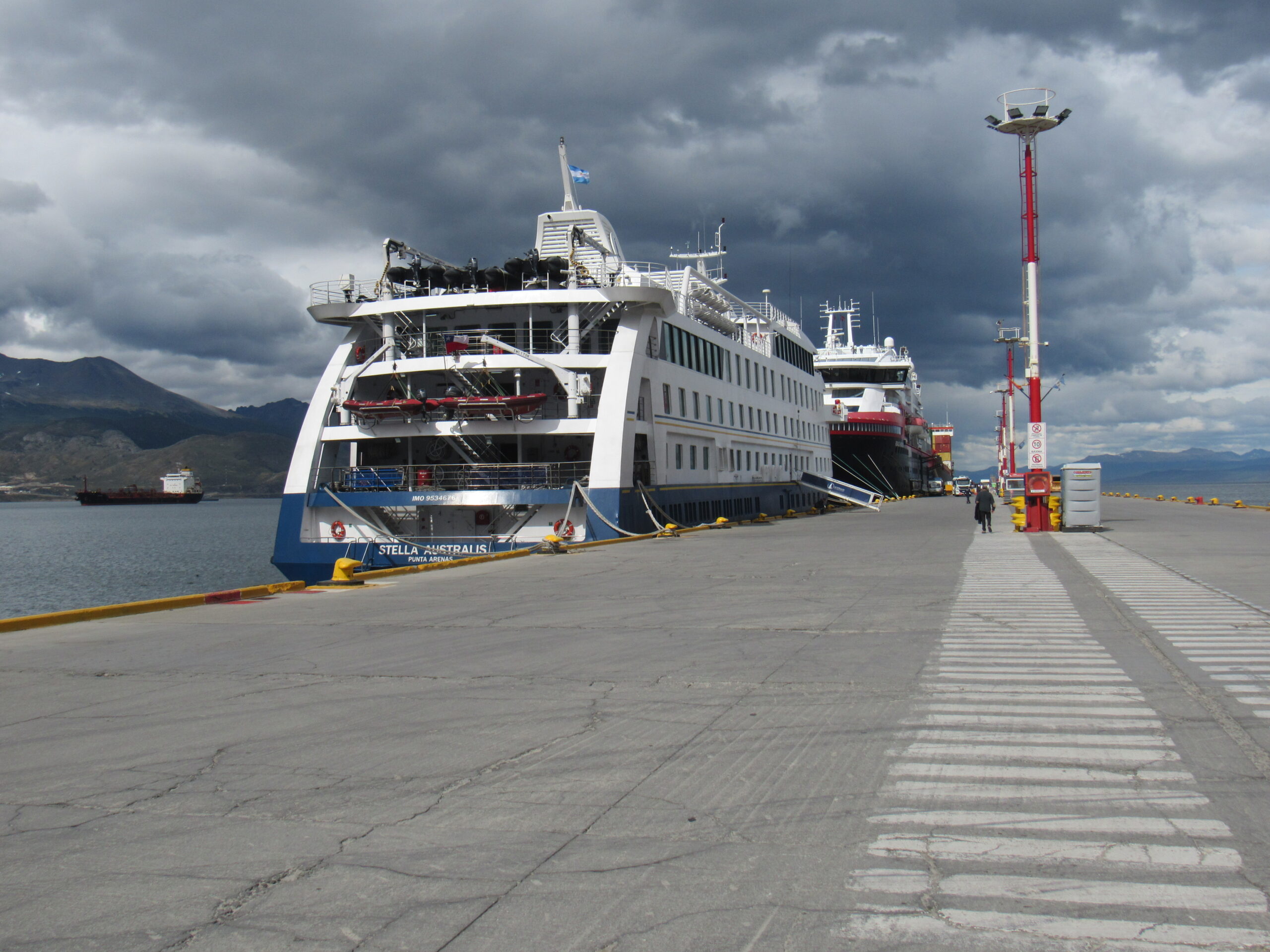
The Stella Australis is based out of Punta Arenas. It has 100 cabins, and spends its time traveling the Chilean fjords.
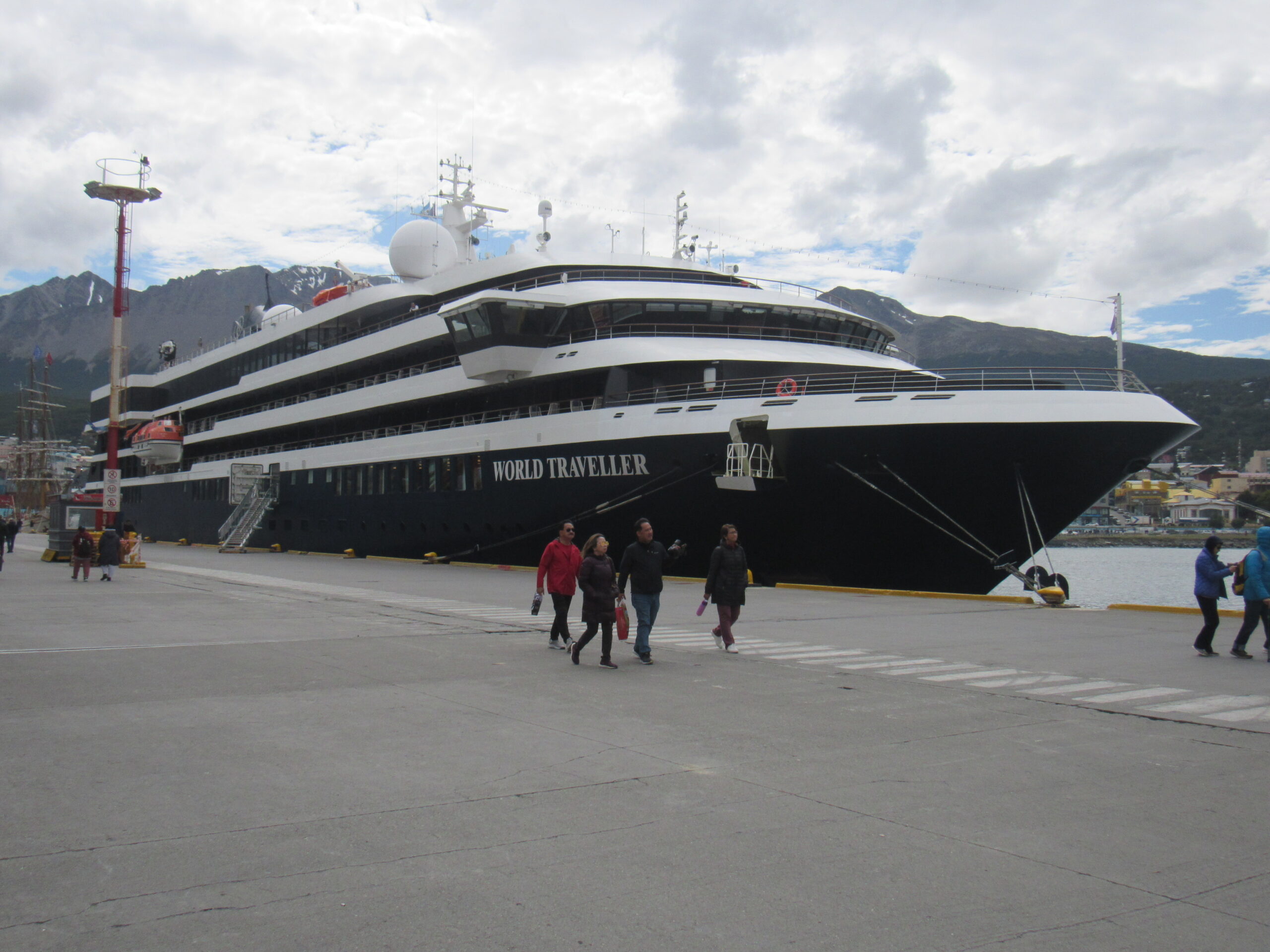
This is the World Traveler. She carries 196 passengers, and goes all the way down to Marguerite Bay, just like my ship the Roald Amundsen.
This next ship was docked nearby. It is the Gene Chaser, and this link provides some fascinating information about her.
But the most impressive vessel of them all sharing pier space with us was this, the bark Europa. We had spotted her a time or two in far southern waters, so she wasn’t shy about taking on the big risks. Here is a link to her website. She is a tiny ship, and carries no more than 40 passengers. If you sign up for one of her cruises, you also need to perform crew duties. I can’t imagine doing a rough crossing of the Drake Passage in her – that’d be way above my pay grade.
Because of the strike, instead of flying home, we spent a leisurely day in port. Some passengers walked into town and spent the evening pubbing, but I didn’t feel up to it. During the day, though, I did manage to confirm my re-scheduled flight from Buenos Aires to Atlanta.
Talk about an early start! We had to vacate our rooms by 4:00 AM. Down in the dining room, the kitchen staff had a buffet meal ready for us so we could enjoy a proper breakfast before traveling. While there, I struck up a conversation with an interesting American couple. When I asked them which city they called home, their reply caught me off-guard. They said they neither owned nor rented a home; the didn’t own a car; they didn’t have any furniture or any of the usual possessions the rest of us take for granted. They spent their lives traveling from one destination to another, usually on cruises. When one ended, they headed directly to the next one. In other words, their lives were one endless excursion, and they said they’d been doing it for years and wouldn’t trade it for any other lifestyle.
By 5:00 AM, we disembarked for the last time. They scanned our ID badges and we turned them in, then boarded the waiting buses. A ride through the breaking day took us to the airport, where we entered and were reunited with our luggage. Taking our places in a massive line, we eventually checked our bags and then went to a departure gate.
When I first visited Ushuaia in 1991, the airport was tiny and primitive. There was little air traffic, and flying in was quite the adventure. The old airstrip was only 5,900 feet long and ran in a north-south direction. Planes had to cross over the 4,500-foot Montes Martial, then drop like a stone down to the Beagle Channel and land heading north towards the city. It was tricky, requiring a good pilot, and even so, there were accidents. By 1995, that had all changed. A new runway had been built, a full 9,560 feet long. It could accommodate a 747, and Air France even landed the Concorde there a couple of times. This one ran east-west, and planes could approach from the east across more forgiving terrain and land much more safely.
Eventually we boarded our Jetsmart charter and endured another 3 1/2-hour flight in those horribly-uncomfortable seats and were fed another lunch of a roll with mystery filling – it was all any of us could do to gag down a few bites before giving up. We landed in Buenos Aires around 11:00 AM and parked way out on the tarmac – buses drove us to an obscure entrance to the terminal. Once inside, the fun began.
We stood in a big line, and when our turn came, they checked to see that we had a ticket and a passport. Then we made our way into an even-longer line. Our baggage was x-rayed, then we enjoyed a full-body scan, wanding and a pat-down. Next came a line where you waited your turn to speak to an agent at a booth who checked boarding pass and passport, took a photo of your face and a thumbprint. Once all of that rigamarole was complete, we were free to go to our departure gate.
Because of the lingering effects of the general strike, no gate had yet been assigned to my flight, and anyway it was still 7 hours until my departure time. I found a quiet food court area and spent a few hours emailing and reading my Kindle. Around 4:00 PM, I moved to a quieter area. The Delta app on my phone then gave me an inkling that boarding for my 9:00 PM flight might start around 8:00 PM from Gate 4.
Big new development – at around 7:00 PM, I learned that my flight would be delayed. Instead of departing at 9:00 PM, it won’t leave until 1:00 AM. Okay, that’s not the end of the world, except it would mean that I’d miss my connecting flight from Atlanta to Tucson. With the help of some fellow passengers, I managed a live phone chat with Delta and arranged a new flight to Tucson; then, quite relieved, I sat back and waited the extra hours until departure.
This entire mess was caused by spinoff effects of the strike. At long last, we were happy to board our jam-packed Boeing 767-400. I sat in the middle section next to 2 skinny Argentine girls, so the flight was fairly comfortable. Unwilling to take any chances due to Covid, I wore a mask the entire time, not taking it off for a single moment of the 10-hour flight. They served us dinner at 2:30 AM and breakfast at 8:00 AM, but I did not partake of either.
Upon landing in Atlanta, I cleared Customs, then went through a very strict security check. I had hours to wait before my next flight, so I had Delta print me a paper boarding pass, then went to a food court and enjoyed a leisurely meal. Eventually, my time came to board my flight to Tucson. It went without incident, and after a total of 17 hours of flying, it was all over. Dottie met me at the airport and we drove home.
It took me a few days to re-adjust to the Northern Hemisphere winter, but once done, I could look back on what I’d accomplished. What a trip it’d been! People go on cruises all over the world, but I firmly believe that today in 2024, the ultimate travel destination has to be Antarctica, especially if you can get really far south where the fewest travelers go. I was fortunate that my cruise ticked all the boxes. Here is a look back on what I’d done.
Total days – 20 Total air miles – 16,282 Total road miles – 120 Total miles at sea – 3,700
Would I say that this trip changed me? Definitely, yes. It gave me an appreciation of a part of the world that has a huge effect on our planet’s climate. It made me appreciate how fragile a place Antarctica is, and how it must be protected. There are individuals, companies and countries that would love to go down there and start digging and drilling for the riches that are known to exist. Hopefully, treaties will continue to be updated and signed by all interested parties so that the continent can be protected and preserved for all future generations to enjoy. If you ever get a chance to go there, I highly recommend it.

